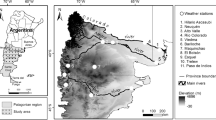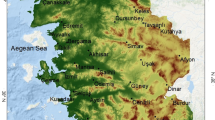Abstract
In this study of the Southern Federal District (SFD) in mainland Russia, the spatial nature and temporal trends of the growing season duration, its provision with thermal energy and moisture, and the phenomena of stress temperature for plants were analyzed on the basis of climatic data from 20 meteorological stations for the period 1960–2018. The growing season length (GSL), frost-free period (FFP), last frost day (LFD), and first frost day (FFD) indices were used as an indicator of the onset time and the duration of the growing season. The growing degree day (GDD) index was used as an indicator of heat supply of the growing season. The Selyaninov’s hydrothermal coefficient (HTC) was used to assess the moisture supply regime. Plant heat stress (PHS) and plant high heat stress (PHHS) were used as indicators of heat stress. In the southern part near the Black Sea coast and in the Caucasus foothills, the most favorable conditions were noted as regards the growing season duration, heat supply of plants, and the moisture regime. The most extreme conditions are typical for the eastern part, where the moisture supply level is low and there are many days with stressful temperatures for plants. Trend analysis of the agro-climatic indices for the SFD territory showed an increase in GSL and FFP mainly due to the later onset of FFD in 1960–2018. In almost every case, there is a statistically significant upward trend in GDD, PHS, and PHHS. For HTC, in general, there is an insignificant downward trend.








Similar content being viewed by others
References
Adhikari U, Nejadhashemi AP, Woznicki SA (2015) Climate change and eastern Africa: a review of impact on major crops. Food and Energy Security 4(2):110–132. https://doi.org/10.1002/fes3.61
Adisa OM, Botai CM, Botai JO, Hassen A, Darkey D, Tesfamariam E, Adisa AF, Adeola AM, Ncongwane KP (2018) Analysis of agro-climatic parameters and their influence on maize production in South Africa. Theor Appl Climatol 134(3–4):991–1004. https://doi.org/10.1007/s00704-017-2327-y
Alexander L, Herold N (2016) ClimPACT2 indices and software. The University of South Wales, Sydney https://github.com/ARCCSSextremes/climpact2. Accessed 7 Feb 2018.
Anandhi A, Perumal S, Gowda PH, Knapp M, Hutchinson S, Harrington J, Murray L, Kirkham MB, Rice CW (2013) Long-term spatial and temporal trends in frost indices in Kansas, USA. Clim Chang 120:169–181. https://doi.org/10.1007/s10584-013-0794-4
Anandhi A (2016) Growing degree days–Ecosystem indicator for changing diurnal temperatures and their impact on corn growth stages in Kansas. Ecol Ind 61:149–158. https://doi.org/10.1016/j.ecolind.2015.08.023
Birsan MV, Micu DM, Nita AI, Mateescu E, Szep R, Keresztesi A (2019) Spatio-temporal changes in annual temperature extremes over Romania (1961–2013). Rom J Phys 64(7–8):816
Ceglar A, Zampieri M, Toreti A, Dentener F (2019) Observed northward migration of agro-climate zones in Europe will further accelerate under climate change. Earth’s Future 7(9):1088–1101. https://doi.org/10.1029/2019EF001178
Chakraborty A, Seshasai MVR, Rao SK, Dadhwal VK (2017) Geo-spatial analysis of temporal trends of temperature and its extremes over India using daily gridded (1 × 1) temperature data of 1969–2005. Theor Appl Climatol 130(1–2):133–149. https://doi.org/10.1029/2019EF001178
Degefie DT, Fleischer E, Klemm O, Soromotin AV, Soromotina OV, Tolstikov AV, Abramov NV (2014) Climate extremes in South Western Siberia: past and future. Stoch Environ Res Risk Assess 28(8):2161–2173. https://doi.org/10.1007/s00477-014-0872-9
Donat MG, Alexander LV, Yang H, Durre I, Vose R, Caesar J (2013) Global land-based datasets for monitoring climatic extremes. Bull Am Meteor Soc 94(7):997–1006. https://doi.org/10.1175/BAMS-D-12-00109.1
Fahad S, Bajwa AA, Nazir U, Anjum SA, Farooq A, Zohaib A, Ihsan MZ (2017) Crop production under drought and heat stress: plant responses and management options. Front Plant Sci 8:1147. https://doi.org/10.3389/fpls.2017.01147
Feng S, Hu Q (2004) Changes in agro-meteorological indicators in the contiguous United States: 1951–2000. Theor Appl Climatol 78(4):247–264. https://doi.org/10.1007/s00704-004-0061-8
Fernández-Long ME, Müller GV, Beltrán-Przekurat A, Scarpati OE (2013) Long-term and recent changes in temperature-based agroclimatic indices in Argentina. Int J Climatol 33:1673–1686. https://doi.org/10.1002/joc.3541
Field CB, Barros V, Stocker TF, Qin D, Dokken DJ, Ebi KL, Mastrandrea MD, Mach KJ, Plattner GK, Allen SK, Tignor M, Midgley PM (eds) (2012) Managing the risks of extreme events and disasters to advance climate change adaptation: special report of the intergovernmental panel on climate change. Cambridge University Press, Cambridge, p 582
Gaupp F, Hall J, Mitchell D, Dadson S (2019) Increasing risks of multiple breadbasket failure under 1.5 and 2 °C global warming. Agric Syst 175:34–45. https://doi.org/10.1016/j.agsy.2019.05.010
Gitz V, Meybeck A, Lipper L, Young CD, Braatz S (2016) Climate change and food security: risks and responses. Food and Agriculture Organization of the United Nations (FAO) Report 110. https://scholar.google.com/scholar_lookup?title=Climate+Change+and+Food+Security:+Risks+and+Responses&author=FAO&publication_year=2016
Graczyk D, Kundzewicz ZW (2016) Changes of temperature-related agroclimatic indices in Poland. Theor Appl Climatol 124:401–410. https://doi.org/10.1007/s00704-015-1429-7
Grigorieva EA, Matzarakis A, de Freitas CR (2010) Analysis of growing degree-days as a climate impact indicator in a region with extreme annual air temperature amplitude. Clim Res 42:143–154. https://doi.org/10.3354/cr00888
Hoegh-Guldberg O, Jacob D, Bindi M et al (2018) Impacts of 1.5 C global warming on natural and human systems. Global warming of 1.5 °C. An IPCC Special Report. IPCC Secretariat, pp 175–311. https://scholar.google.com/scholar?q=.%2C+%E2%80%9CImpacts+of+1.5+%C2%B0C+global+warming+on+natural+and+human+systems%E2%80%9D+%28World+Meteorological+Organization%2C+Geneva%2C+2018%29
Hong YIN, Ying SUN (2018) Characteristics of extreme temperature and precipitation in China in 2017 based on ETCCDI indices. Adv Clim Chang Res 9(4):218–226. https://doi.org/10.1016/j.accre.2019.01.001
IPCC (2014) Climate change 2014: synthesis report. In: Core writing team, Pachauri RK, Meyer L (eds) Contribution of working groups I, II and III to the fifth assessment report of the intergovernmental panel on climate change. IPCC, Geneva
Kaushal N, Bhandari K, Siddique KH, Nayyar H (2016) Food crops face rising temperatures: an overview of responses, adaptive mechanisms, and approaches to improve heat tolerance. Cogent Food & Agriculture 2(1):1134380. https://doi.org/10.1080/23311932.2015.1134380
Kendall MG (1975) Rank correlation methods, 4th edn. Charles Griffin, London
Kukal MS, Irmak S (2018) US Agro-Climate in 20th Century: growing degree days, first and last frost, growing season length, and impacts on crop yields. Sci Rep 8(1):1–14. https://doi.org/10.1038/s41598-018-25212-2
Lesk C, Rowhani P, Ramankutty N (2016) Influence of extreme weather disasters on global crop production. Nature 529:84–87. https://doi.org/10.1038/nature16467
Malinovic-Milicevic S, Radovanovic MM, Stanojevic G, Milovanovic B (2016) Recent changes in Serbian climate extreme indices from 1961 to 2010. Theor Appl Climatol 124(3–4):1089–1098. https://doi.org/10.1007/s00704-015-1491-1
Mann HB (1945) Non-parametric tests against trend. Econometrica 13:245–259
Nichols A (2019) Climate change, natural hazards, and relocation: insights from Nabukadra and Navuniivi villages in Fiji. Clim Change 156(1–2):255–271. https://doi.org/10.1007/s10584-019-02531-5
Nyamtseren M, Feng Q, Deo RA (2018) A comparative study of temperature and precipitation-based aridity indices and their trends in Mongolia. Int J Environ Res 12:887–899. https://doi.org/10.1007/s41742-018-0143-6
O’Neill BC, Oppenheimer M, Warren R (2017) Key risks of climate change: the IPCC reasons for concern. Nature Clim Change 7:28–37. https://doi.org/10.1038/nclimate3179
Ontel I, Vladut A (2015) Impact of drought on the productivity of agricultural crops within the Oltenia Plain. Romania. Geographica Pannonica 19(1):9–19. https://doi.org/10.5937/GeoPan1501009O
Piticar A (2019) Changes in agro-climatic indices related to temperature in Central Chile. Int J Biometeorol 63(4):499–510. https://doi.org/10.1007/s00484-019-01681-6
Porter JR, Xie L, Challinor AJ, Cochrane K, Howden SM, Iqbal MM, Lobell DB, Travasso MI (2014) Food security and food production systems. In: Climate Change 2014: Impacts, Adaptation, and Vulnerability. Field C.B., Barros V.R., Dokken DJ, Mach KJ, Mastrandrea MD, Bilir TE, Chatterjee M, Ebi KL, Estrada YO, Genova RC, Girma B, Kissel ES, Levy AN, MacCracken S, Mastrandrea PR, White LL (Eds.), Part A: Global and sectoral aspects. Contribution of working group II to the Fifth Assessment Report of the Intergovernmental Panel on Climate Change. Cambridge University Press, Cambridge
Roshydromet (2019) Report on climate features in the Russian Federation in 2018 [in Russian]. http://www.meteorf.ru/upload/pdf_download/o-klimate-rf-2018.pdf
Rosstat (2020a) Unified interdepartmental information and statistical system of the Russian Federation https://www.fedstat.ru/indicator/37662. Accessed 21.05.2020
Rosstat (2020b) Unified interdepartmental information and statistical system of the Russian Federation https://www.fedstat.ru/indicator/31328. Accessed 22.05.2020
Ruml M, Gregorić E, Vujadinović M, Radovanović S, Matović G, Vuković A, Stojičić D (2017) Observed changes of temperature extremes in Serbia over the period 1961–2010. Atmos Res 183:26–41. https://doi.org/10.1016/j.atmosres.2016.08.013
Russian Research Institute of Hydrometeorological Information – World Data Center (RRIHI-WDS) (2020). Obninsk Russia available at: http://aisori-m.meteo.ru. Last access: April 2020
Salmi T, Määttä A, Anttila P, Ruoho-Airola T, Amnell T (2002) Detecting trends of annual values of atmospheric pollutants by the Mann-Kendall test and Sen’s slope estimates—The excel template application MAKESENS. Publications of air quality Finnish Meteorological Institute. No 31. Ilmatieteen laitos, Helsinki. https://scholar.google.com/scholar_lookup?title=Detecting+Trends+of+Annual+Values+of+Atmospheric+Pollutants+by+the+Mann-Kendall+Test+and+Sen%C2%B4s+Slope+Estimates%E2%80%94The+Excel+Template+Application+MAKESENS&author=Salmi,+T.&author=M%C3%A4%C3%A4tt%C3%A4,+A.&author=Anttila,+P.&author=Ruoho-Airola,+T.&author=Amnell,+T.&publication_year=2002
Selyaninov GT (1930) Methods of agricultural climatology. Agricultural Meteorology 22 L. [in Russian] https://scholar.google.com/scholar?q=Selyaninov%2C%20G.T.%20%281930%29%20Methods%20of%20Agricultural%20Climatology%2C%20in%20Agricultural%20Meteorology%2C%20No.%2022%20L
Veselov VM (2002) PC archives of the State Data Holding and technology of their organization. Proc RIHMI-WDC 170:16–30. https://scholar.google.com/scholar?hl=ru&as_sdt=0%2C5&q=Veselov+VM+%282002%29+PC+archives+of+the+State+Data+Holding+and+technology+of+their+organization.+Proc+RIHMI-WDC+170%3A16%E2%80%9330&btnG=
Vlăduţ A, Nikolova N, Licurici M (2017) Aridity assessment within southern Romania and northern Bulgaria. Croatian Geogr Bull 79(2):5–26. https://doi.org/10.21861/HGG.2017.79.02.01
Vlăduţ AȘ, Licurici M (2020) Aridity conditions within the region of Oltenia (Romania) from 1961 to 2015. Theor Appl Climatol 140:589–602. https://doi.org/10.1007/s00704-020-03107-5
Wypych A, Sulikowska A, Ustrnul Z, Czekierda D (2017) Variability of growing degree days in Poland in response to ongoing climate changes in Europe. Int J Biometeorol 61:49–59. https://doi.org/10.1007/s00484-016-1190-3
Yao J, Chen Y, Zhao Y, Mao W, Xu X, Liu Y, Yang Q (2018) Response of vegetation NDVI to climatic extremes in the arid region of Central Asia: a case study in Xinjiang, China. Theor Appl Climatol 131:1503–1515. https://doi.org/10.1007/s00704-017-2058-0
Zhang X, Alexander L, Hegerl GC, Jones P, Tank AK, Peterson TC, Trewin B, Zwiers FW (2011) Indices for monitoring changes in extremes based on daily temperature and precipitation data. Wires Clim Change 2:851–870. https://doi.org/10.1002/wcc.147
Zhang Z, Yang X, Liu Z, Bai F, Sun S, Nie J, Li S (2020) Spatio-temporal characteristics of agro-climatic indices and extreme weather events during the growing season for summer maize (Zea mays L.) in Huanghuaihai region. China Int J Biometeorol 64:827–839. https://doi.org/10.1007/s00484-020-01872-6
Zhou D, Hao L, Kim JB, Liu P, Pan C, Liu Y (2019) Sun G (2019) Potential impacts of climate change on vegetation dynamics and ecosystem function in a mountain watershed on the Qinghai-Tibet Plateau. Clim Change 156:31–50. https://doi.org/10.1007/s10584-019-02524-4
Funding
The research was financially supported by the Ministry of Science and Higher Education of the Russian Federation within the framework of the state task in the field of scientific activity (no. 0852–2020-0029).
Author information
Authors and Affiliations
Contributions
VG: Writing- Original draft preparation. AU, AI: Conceptualization. VG, YD, VS, KA: Investigation, Formal analysis.
Corresponding author
Ethics declarations
Conflict of interest
The authors declare that they have no conflict of interest.
Additional information
Publisher's note
Springer Nature remains neutral with regard to jurisdictional claims in published maps and institutional affiliations.
Rights and permissions
About this article
Cite this article
Gudko, V., Usatov, A., Ioshpa, A. et al. Agro-climatic conditions of the Southern Federal District of Russia in the context of climate change. Theor Appl Climatol 145, 989–1006 (2021). https://doi.org/10.1007/s00704-021-03677-y
Received:
Accepted:
Published:
Issue Date:
DOI: https://doi.org/10.1007/s00704-021-03677-y





